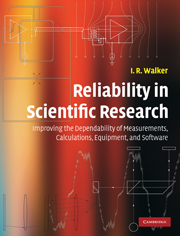 Reliability in Scientific Research
Reliability in Scientific Research Published online by Cambridge University Press: 05 June 2012
Introduction
The design and construction of scientific apparatus is often accompanied by serious pitfalls. These can be a cause of much wasted time, and a source of frustration to those who are not familiar with the problems. This chapter examines a few of most common difficulties, and some useful general strategies for easing the development of reliable apparatus. Detailed design and construction considerations are discussed elsewhere in the book, and in the references at the end of the chapter.
Commercial vs. self-made items
One should generally not make equipment and parts that can be obtained commercially. An important reason for this is that it very often takes much longer to design and construct such items in a research laboratory than is originally envisaged (see Section 5.3). Most of the things that are done in a laboratory are not new. Hence, much time and effort can be saved by making full use of the multitude of products that are available on the market, and easily located on the Web.
Many commercial devices of a given type may be made by a company, and several generations may be designed and manufactured over the years. For this reason, the people who design these devices (often professional engineers) frequently have considerable experience in dealing with their potential problems. Furthermore, since large development costs can be spread out over many units, the reliability, ease-of-use, and performance of these can be much higher, given the cost, than those of equivalent devices designed and built in-house.
To save this book to your Kindle, first ensure [email protected] is added to your Approved Personal Document E-mail List under your Personal Document Settings on the Manage Your Content and Devices page of your Amazon account. Then enter the ‘name’ part of your Kindle email address below. Find out more about saving to your Kindle.
Note you can select to save to either the @free.kindle.com or @kindle.com variations. ‘@free.kindle.com’ emails are free but can only be saved to your device when it is connected to wi-fi. ‘@kindle.com’ emails can be delivered even when you are not connected to wi-fi, but note that service fees apply.
Find out more about the Kindle Personal Document Service.
To save content items to your account, please confirm that you agree to abide by our usage policies. If this is the first time you use this feature, you will be asked to authorise Cambridge Core to connect with your account. Find out more about saving content to Dropbox.
To save content items to your account, please confirm that you agree to abide by our usage policies. If this is the first time you use this feature, you will be asked to authorise Cambridge Core to connect with your account. Find out more about saving content to Google Drive.